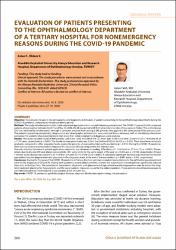Evaluation of patients presenting to the ophthalmology department of a tertiary hospital for nonemergency reasons during the covid-19 pandemic
Özet
Objective: To evaluate changes in the demographic and diagnostic distribution of patients presenting to the ophthalmology department during the COVID-19 pandemic, compared to the pre-pandemic period. Methods: The study included patients who made outpatient appointments in our ophthalmology department. The COVID-19 group (CovG) comprised patients who presented between April 15 and May 15, 2020, the 30-day period with the highest daily number of new cases in Turkey. The control group (CG) was obtained by randomization through a computer program from among 2 245 patients who applied in the same period of the previous year. The patients’ presenting complaint(s), diagnostic(s) and demographic information’s were collected from a database, with all identifying information concealed. For patients who presented more than once, their initial complaint and diagnoses were analyzed. Results: The study included a total of 400 patients: 200 in the CovG and 200 in the CG. Mean ages in the CovG and CG were 41.23 ± 14.48 and 48.20 ± 17.49 years, respectively (p < 0.001). The female to male patient ratio was 0.53 in the CovG and 0.83 in the CG (p = 0.032). There were fewer university graduates compared to other education levels among the patients who presented during the pandemic (p = 0.013). During the COVID-19 pandemic, there was no increase in presentation frequency for any ocular disease compared to the previous year. The only statistical decrease in patient application complaints was observed in reading difficultness (11 % in CovG vs. 37 % in CG; p < 0.001). Presentations due to dry eye (DE) and allergic conjunctivitis (AC) were similar to the same period of the year (p = 0.303 and p = 0.550, respectively). At least 1 chronic ocular disease was present in 25 % of the CovG and 45.5 % of the CG (p < 0.001). A statistically significant decrease was observed in CovG for age-related macular degeneration and glaucoma in the diagnoses made at the end of the examination (p = 0.001 and p < 0.001, respectively). Conclusion: During the first peak of the COVID-19 pandemic in Turkey, the most common outpatient presentations to the ophthalmology department were for the diagnoses of DE and AC. During peak pandemic period, elderly patients, women and academically trained patients significantly reduced their visits to the Eye Clinic. The reduction in presentation of patients with glaucoma and age-related macular degeneration may be due to the longterm treatment planning for these patients and the social isolation measures issued for the older population. These patients should be encouraged to use video consultation / telemedicine in eye patients at risk of vision loss.
Kaynak
Ceska a Slovenska OftalmologieCilt
76Sayı
6Bağlantı
https://www.scopus.com/record/display.uri?eid=2-s2.0-85102804197&origin=resultslist&sort=plf-f&src=s&nlo=&nlr=&nls=&sid=20c4fe371b9b908d4f7e419f791331ff&sot=aff&sdt=cl&cluster=scofreetoread%2c%22all%22%2ct&sl=72&s=AF-ID%28%22Alanya+Alaaddin+Keykubat+University%22+60198720%29+AND+SUBJAREA%28MEDI%29&relpos=163&citeCnt=2&searchTerm=https://hdl.handle.net/20.500.12868/2447
https://www.cs-ophthalmology.cz/en/journal/articles/177


















